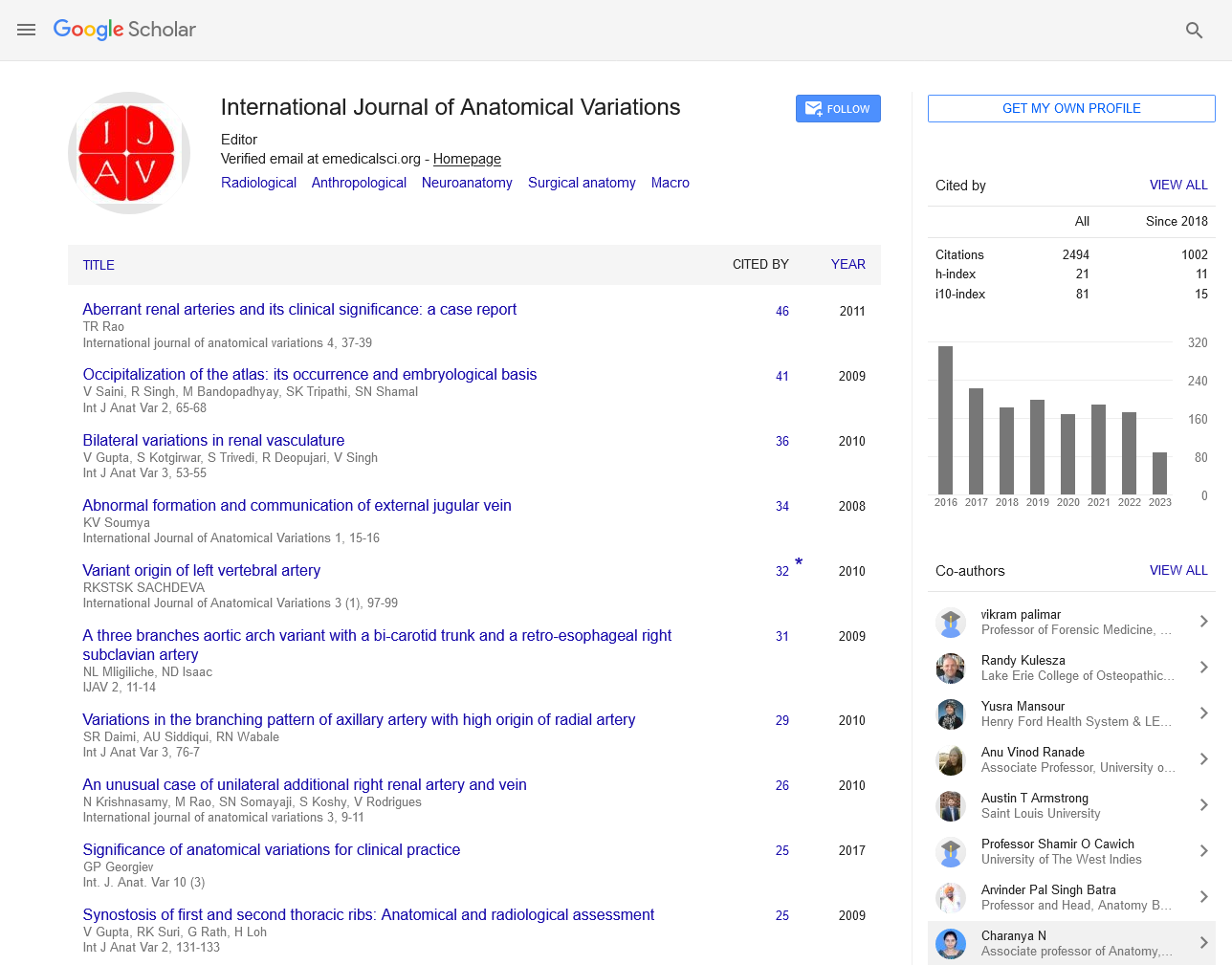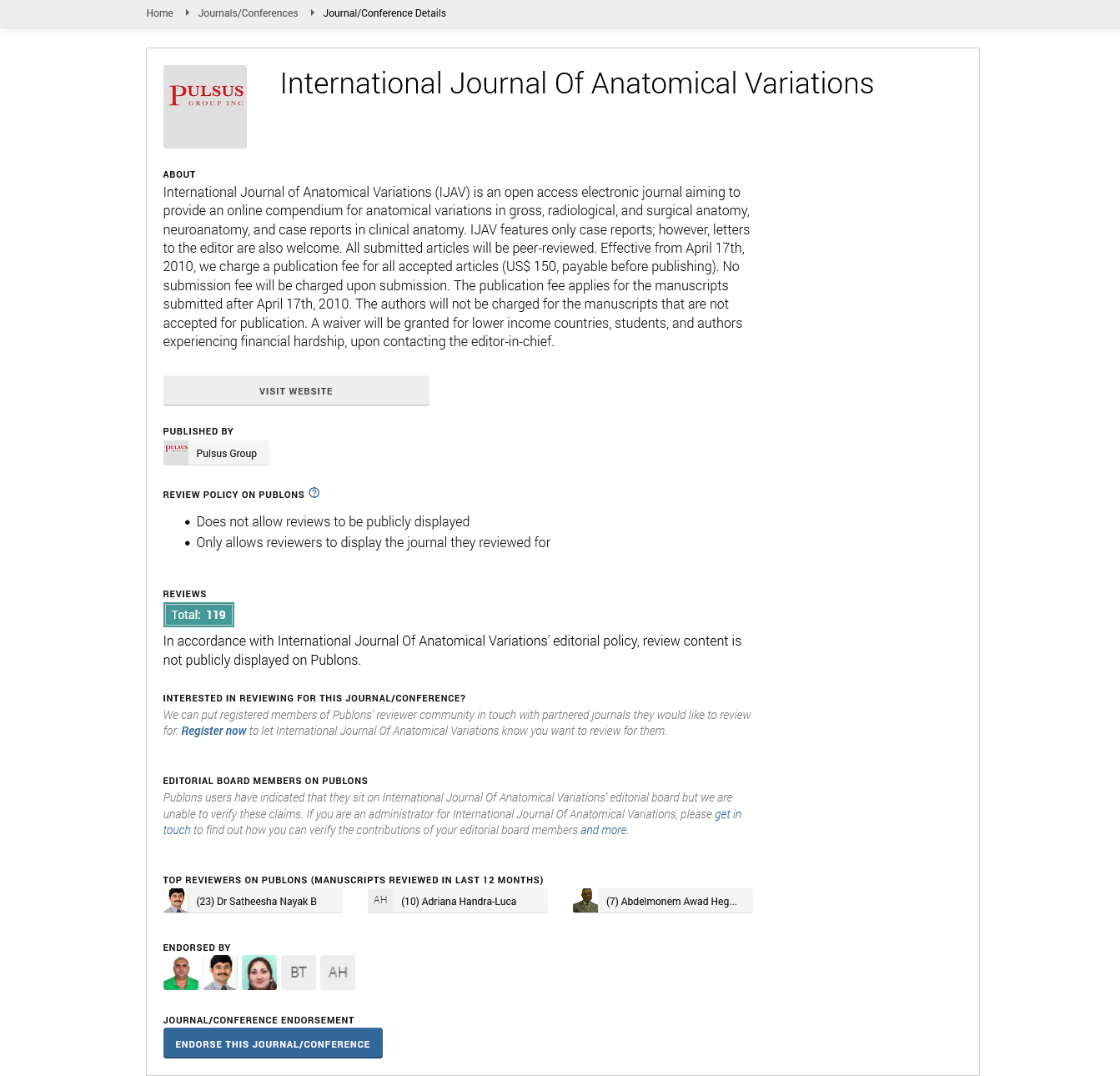An Overview and Basic Structure of Human Anatomy
Received: 01-Mar-2025, Manuscript No. ijav-25-7634; Editor assigned: 04-Mar-2025, Pre QC No. ijav-25-7634 (PQ); Reviewed: 19-Mar-2025 QC No. ijav-25-7634; Revised: 26-Mar-2025, Manuscript No. ijav-25-7634 (R); Published: 30-Mar-2025, DOI: 10.37532/1308 4038.18(3).492
Citation: Nayak G. An Overview and Basic Structure of Human Anatomy. Int J Anat Var. 2025; 18(3): 754-755.
This open-access article is distributed under the terms of the Creative Commons Attribution Non-Commercial License (CC BY-NC) (http://creativecommons.org/licenses/by-nc/4.0/), which permits reuse, distribution and reproduction of the article, provided that the original work is properly cited and the reuse is restricted to noncommercial purposes. For commercial reuse, contact reprints@pulsus.com
Abstract
Embryological development plays a fundamental role in shaping the vascular and nervous systems. Anatomical variations arising during development may influence surgical outcomes and diagnostic interpretation. This paper explores the embryological basis of vascular and neural anatomical variations and highlights their implications in clinical practice.
INTRODUCTION
uman anatomy is the branch of biology that focuses on the structure and organization of the human body. Understanding human anatomy is essential for various fields such as medicine, physiotherapy, and biology. The study of human anatomy can be divided into two main subfields: gross anatomy [1], which studies the structures visible to the naked eye, and microscopic anatomy, which delves into the details of cells and tissues. This article provides an overview of human anatomy, outlining the body’s basic structure, major organ systems, and the importance of anatomical knowledge in healthcare. Human anatomy is the scientific study of the structure and organization of the human body. It plays a critical role in understanding how the body functions, how various systems work together, and how they contribute to maintaining health and homeostasis. The study of human anatomy dates back centuries [2], with early contributions from renowned scholars such as Hippocrates and Vesalius, whose discoveries laid the foundation for modern medical practices. Anatomy can be categorized into two primary subfields: gross anatomy, which focuses on the examination of structures visible to the naked eye, and microscopic anatomy, which looks at the fine details of tissues and cells under a microscope. By studying both the macroscopic and microscopic levels, human anatomy helps explain the body’s complex design and the interconnectivity of its systems. This article provides a comprehensive overview of the basic structure of the human body, focusing on the major organ systems, their functions, and how they interact to support life. Understanding this foundational knowledge is essential not only for students of medicine and biology but also for anyone interested in how the human body operates at a structural level [3].
The Human Body: A Basic Structural Overview
The human body is composed of several interrelated systems, all of which work together to maintain homeostasis, protect against disease, and enable the functioning of vital processes. These systems include the musculoskeletal, circulatory, respiratory, digestive, nervous, endocrine, immune, and reproductive systems, among others [4].
SKELETAL SYSTEM
The skeletal system serves as the body’s framework. It is made up of bones, cartilage, and joints that not only provide structure but also protect vital organs, store minerals, and produce blood cells. There are 206 bones in the adult human skeleton, and they are categorized into two major parts. This includes the skull, vertebral column, and rib cage. This consists of the limbs and girdles that attach them to the body.
MUSCULAR SYSTEM
The muscular system is responsible for movement. Voluntary muscles attached to bones, responsible for movement. Involuntary muscles found in the walls of internal organs like the stomach and intestines. The involuntary muscle found in the heart, responsible for pumping blood. Muscle fibers contract in response to neural stimulation, enabling both voluntary and involuntary movements [5].
NERVOUS SYSTEM
The nervous system is responsible for transmitting signals between different parts of the body. Includes the brain and spinal cord. Consists of nerves that extend from the CNS to the rest of the body. The nervous system allows humans to respond to external stimuli, maintain coordination, and regulate bodily functions.
RESPIRATORY SYSTEM
The respiratory system is essential for gas exchange. It provides oxygen to the blood and removes carbon dioxide. The primary organ for gas exchange. Passageways that transport air to the lungs. A muscle that aids in breathing.
DIGESTIVE SYSTEM
The digestive system breaks down food to absorb nutrients. It includes the mouth, esophagus, stomach, intestines, and accessory organs like the liver and pancreas. The digestive process involves mechanical and chemical breakdown of food into molecules that can be absorbed and used by the body.
ENDOCRINE SYSTEM
The endocrine system is composed of glands that produce hormones, which regulate metabolism, growth, reproduction, and mood. The "master gland" that controls other endocrine glands. Involved in metabolism and calcium regulation. Release hormones related to stress response.
CONCLUSION
Human anatomy is fundamental to understanding how the body functions and how different systems work together. This foundational knowledge is essential for health professionals who diagnose, treat, and manage human health. By studying the structure and function of the human body, researchers can explore medical advancements and provide better healthcare solutions.
REFERENCES
- Mujagic S, Kozic D, Huseinagic H, Smajlovic D. Symmetry, asymmetry and hypoplasia of intracranial internal carotid artery on magnetic resonance angiography. Acta Med Acad. 2016; 45:1- 9.
- Rusu MC, Vrapclu AD, Lazar M. A rare variant of accessory cerebral artery. Surg Radiol Anat. 2023; 45(5):523-526.
- Krause DA, Youdas JW. Bilateral presence of a variant subscapularis muscle. Int J Anat Var. 2017; 10(4):79-80.
- Mann MR, Plutecki D, Janda P, Pękala J, Malinowski K, et al. The subscapularis muscle‐a meta‐analysis of its variations, prevalence, and anatomy. Clin Anat. 2023; 36(3):527-541.
- Pillay M, Jacob SM. Bilateral presence of axillary arch muscle passing through the posterior cord of the brachial plexus. Int. J. Morphol., 27(4):1047-1050, 2009.
Indexed at, Google Scholar, Crossref
Indexed at, Google Scholar, Crossref
Indexed at, Google Scholar, Crossref






